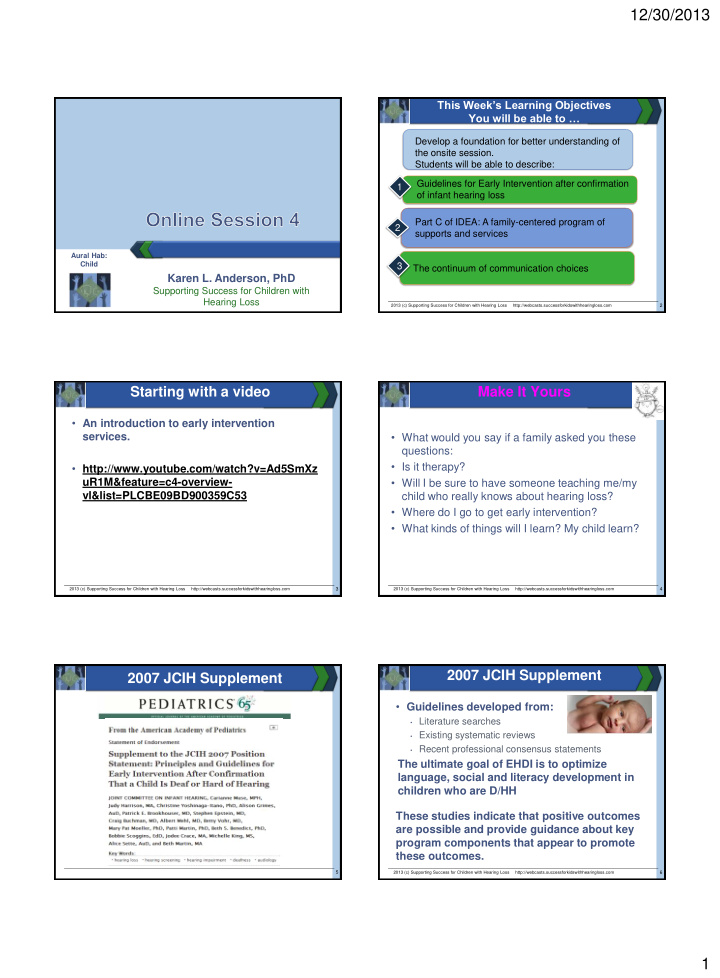



12/30/2013 This Week’s Learning Objectives You will be able to … Develop a foundation for better understanding of the onsite session. Students will be able to describe: Guidelines for Early Intervention after confirmation 1 of infant hearing loss Part C of IDEA: A family-centered program of 2 supports and services Aural Hab: Child 3 The continuum of communication choices Karen L. Anderson, PhD Supporting Success for Children with Hearing Loss 2013 (c) Supporting Success for Children with Hearing Loss http://webcasts.successforkidswithhearingloss.com 2 Starting with a video Make It Yours • An introduction to early intervention services. • What would you say if a family asked you these questions: • Is it therapy? • http://www.youtube.com/watch?v=Ad5SmXz • Will I be sure to have someone teaching me/my uR1M&feature=c4-overview- vl&list=PLCBE09BD900359C53 child who really knows about hearing loss? • Where do I go to get early intervention? • What kinds of things will I learn? My child learn? 2013 (c) Supporting Success for Children with Hearing Loss http://webcasts.successforkidswithhearingloss.com 3 2013 (c) Supporting Success for Children with Hearing Loss http://webcasts.successforkidswithhearingloss.com 4 2007 JCIH Supplement 2007 JCIH Supplement • Guidelines developed from: • Literature searches • Existing systematic reviews • Recent professional consensus statements The ultimate goal of EHDI is to optimize language, social and literacy development in children who are D/HH These studies indicate that positive outcomes are possible and provide guidance about key program components that appear to promote these outcomes. 5 2013 (c) Supporting Success for Children with Hearing Loss http://webcasts.successforkidswithhearingloss.com 6 1
12/30/2013 EHDI Best Practice Goal 1 • Establish a timely, coordinated system of entry • Programs have been established 10 – 20+ into EI services following HL confirmation years, depending on state • Timely Access as defined by 2007 Supplement • Most states still are not able to report early • Referral to Part C within 2 days of audiologic intervention outcomes confirmation & Implementation of Early Intervention services within 45 days of referral) • No hard data to support that communicative • Part C regulations (2011) require referral as soon as delays are being prevented/minimized possible but in no case more than 7 days after • The 2007 Supplement is designed to provide identification of hearing loss support for the development of accountable • Giving families EIP contact information does not fulfill this and appropriate EI follow-through systems. legal requirement • 12 Goals – desire is to attain 90% of all goals • Audiologists need to obtain parent permission to report to within 5 years local EIP. Also required to report to state EHDI who will then contact Early Intervention (states will vary). 2013 (c) Supporting Success for Children with Hearing Loss http://webcasts.successforkidswithhearingloss.com 7 2013 (c) Supporting Success for Children with Hearing Loss http://webcasts.successforkidswithhearingloss.com 8 Best Practice Goal 1 Best Practice Goal 1 Per FL Guidelines: The following should be completed • Develop a mechanism that ensures family immediately after assessment for infants with hearing loss: access to all available resources and • Complete the “Follow -up Diagnostic Evaluation Results Form information for Community Audiologists” with copies to be faxed to the Children’s Medical Services Newborn Screening Unit • EI programs • The “Follow -up Diagnostic Evaluation Results Form for • Website resources on deafness and hearing loss Community Audiologists” form should also be faxed to the • National organization resources for families local Early Intervention Program within 2 working days of • Terms/definitions related to hearing loss confirmation of hearing loss. • Infrastructure of state resources for families • Audiologists should refer the child to early intervention at the • Services available through Part C point of confirmation of hearing loss and not delay the referral • Communication choices, definitions, factors to until complete threshold information is obtained. consider • This fax will constitute a referral and will satisfy the http://www.floridahealth.gov/AlternateSites/CMS- requirements of the Federal Law (CFR 303.321d). Kids/home/resources/es_policy_0710/Attachments/6_SHINE_FlaResourceGuideforFamilies- HearingLoss-May2011.pdf#search="family resource guide" 2013 (c) Supporting Success for Children with Hearing Loss http://webcasts.successforkidswithhearingloss.com 9 2013 (c) Supporting Success for Children with Hearing Loss http://webcasts.successforkidswithhearingloss.com 10 Best Practice Goal 1 Best Practice Goal 2 • Dissemination of unbiased and accurate information • Timely access to Service Coordinators who have specialized knowledge and skills related to working • Florida: SHINE = Serving Hearing Impaired Newborns with DHH Effectively • First point of contact for families • SHINE provides a framework for services within the • Oversees development/implementation of the IFSP – Early Steps system to meet the unique needs of children with hearing loss (birth to 36 months) and their families. Individualized Family Service (Support) Plan • Component 6: EI Services • Coordinates appropriate assessments • http://www.floridahealth.gov/AlternateSites/CMS- • Gathers the ‘right people’ on the IFSP team Kids/home/resources/es_policy/es_Policy.html • More info see SHINE Tend to be social workers or early childhood educators Procedural Guidance Tend to have high caseloads Tend toward not staying service coordinators very long Challenging to have designated DHH service coordinators 2013 (c) Supporting Success for Children with Hearing Loss http://webcasts.successforkidswithhearingloss.com 11 2013 (c) Supporting Success for Children with Hearing Loss http://webcasts.successforkidswithhearingloss.com 12 2
Recommend
More recommend